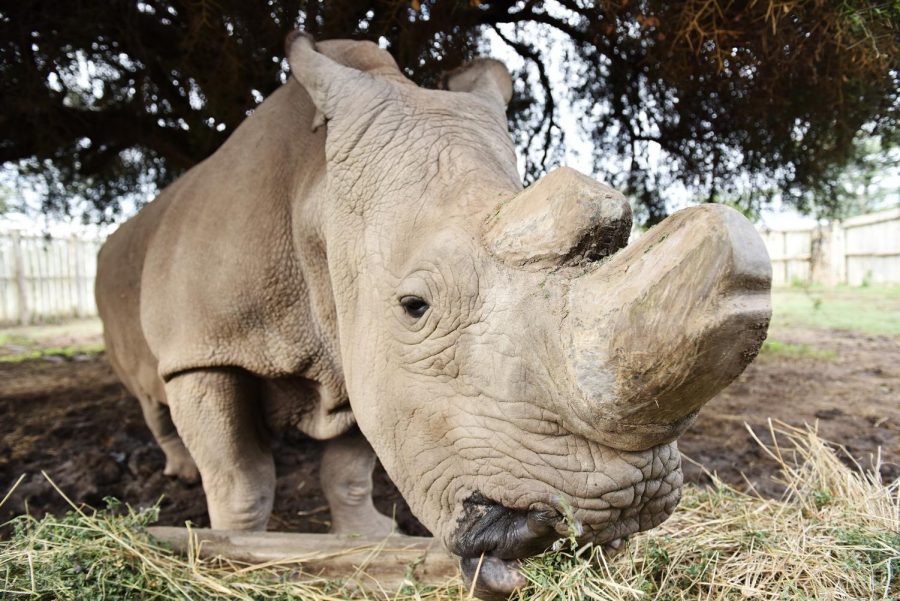Sudan, last male rhino of his species, in discouraging health
(Sun Ruibo/Xinhua/Sipa USA/TNS)
Sudan, the last male northern white rhino, feeds himself inside an enclosure at Ol Pejeta Conservancy in Nanyuki, Kenya, on April 18, 2015.
UPDATE: According to Ol Pejeta, Sudan died on March 19. His daughter and granddaughter are now the only northern white rhinos to exist on Earth. Genetic material was taken from Sudan on the same day, with hopes to expand the species in the future.
The last male northern white rhino on the planet may be seeing end of his lengthy journey soon.
Sudan, a 45-year-old northern white rhino, is being kept at the Ol Pejeta Conservancy in Kenya. He recently underwent treatment for a bedsore infection, brought on by his lack of mobility.
On March 5, a spokesman for the reserve told BBC that they were not holding out “big hopes” for a miracle recovery.
Ol Pejeta’s Elodie Sampere spoke to BBC about Sudan. She said that the animal – who is 90 in rhino years – has had his medical problems made worse by old age.
Sampere said that the reserve was treating the rhino’s wounds twice a day to avoid risk of infection.
“The sores are being made worse because he lies down too much,” she said.
However, with consistent treatment in recent days, Sudan has been slowly improving in his movement.
Sudan has been under the care of the reserve since 2009, along with two female companions, both of whom he has failed to mate with. He was retired as a potential mate four years ago.
This essentially means that the three northern white rhinos in Kenya are the last of their species.
The three rhinos are being protected 24/7 by armed guards, to prevent against poachers.
Poaching has been the primary cause for the species to be listed as “critically endangered (possibly extinct in the wild)” by the International Union for Conservation of Nature (IUCN) in 2011.
However, poaching isn’t the cause for Sudan’s pain, it’s his age.
Sudan had dealt with a previous infection on his back right leg late last year, but he recovered to good health once again. This second infection was discovered recently in the same area.
“The Most Eligible Bachelor in the World” is what Sudan was named on the popular dating app Tinder last year. This was all part of a fundraiser to help develop in vitro fertilization (IVF) for the rhinos, which has never been done before.
IVF could be a way of keeping the species alive, by combining a female egg and male sperm in a laboratory.
Ol Pejeta Conservancy and Tinder launched a joint campaign in an effort to save the species. Users had the option to donate to the IVF fund if they wished.
His Tinder profile at the time read: “I don’t mean to be too forward, but the fate of my species literally depends on me.”
“I perform well under pressure… 6ft (183cm) tall and 5,000lb (2,268kg) if it matters.”
Conservationists overseeing the efforts said they need $10 million to develop IVF for use with the species. They hope to keep Sudan alive as long as they can, but they believe they are racing against the clock to achieve their goal.
Using Sudan’s sperm for IVF on southern white rhinos is not out of the question entirely, as breeding the two species together is still better than complete extinction, conservationists have said.
Southern white rhinos have made their comeback from extinction already, from 840 individuals in the 1960s to between 19,682 and 21,077 since the last census in 2015. They are now the most abundant species of rhinoceros on the planet.
The London-based group Save the Rhino believes that it may very well be too late for the northern white species, however.
“With small chance of healthy new calves, and limited place in their historic range to go, Save the Rhino believes that the best outcome will be to put our efforts and funding — including research into IVF — into saving the species which do still have a chance,” it said on its website.
Some other conservationists believe that efforts should be focused on other critically endangered species such as the Javan and Sumatran rhinos, that have suffered due to poaching and human encroachment, according to the Washington Post. Both species are located in Asia.
Fewer than 100 of the Javan and Sumatran species remain.
On March 9, Ol Pejeta tweeted that Sudan’s improving mobility may be encouraging for the coming days.
https://www.instagram.com/p/BgGuLmoAzPm/?hl=en&taken-by=olpejeta
Ol Pejeta receives thousands of visitors to see Sudan, who has become a bit of a celebrity.
Many of those visitors, if not all, are now well aware that Sudan is one of the last of his kind on Earth.
Tyler Newman can be found on Twitter @tnewman39.











